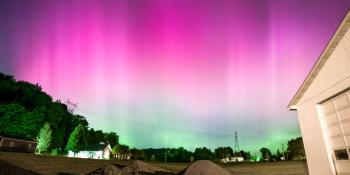Viendo archivo del viernes, 11 marzo 2011
Informe actividad solar
Any mentioned solar flare in this report has a scaling factor applied by the Space Weather Prediction Center (SWPC). Because of the SWPC scaling factor, solar flares are reported as 42% smaller than for the science quality data. The scaling factor has been removed from our archived solar flare data to reflect the true physical units.
Informe de actividad Solar-Geofísica 2011 Mar 11 2200 UTCPreparado por NOAA © SWPC y procesado por SpaceWeatherLive.com
Informe conjunto USAF/NOAA de actividad Solar y Geofísica
SDF Número 070 Publicado el 2200Z a las 11 Mar 2011IA. Análisis de regiones solares activas y de actividad desde 10-2100Z hasta 11-2100Z Solar activity was moderate. A single M1 flare was
observed from Region 1166 (N09W39) at 10/2241Z. Region 1166
decreased in area while the number of spots increased. It was
classified as an Ekc type sunspot group with Beta-Gamma-Delta
magnetic characteristics. Region 1169 (N20W09) grew in both area
and spot count, ending the period as an Eki type sunspot group with
Beta-Gamma magnetic characteristics. New Region 1172 (N11E72)
rotated onto the visible solar disk as a bi-polar sunspot group.
IB. Pronóstico de la actividad solar
Solar activity is expected to remain
moderate for the next three days (11-13 March).
IIA. Resumen de la actividad geofísica 10-2100Z a 11-2100Z
The geomagnetic field ranged from quiet to active levels at
mid-latitudes with minor to major storm levels observed at high
latitudes. The ACE spacecraft indicated the Bz component of the
interplanetary magnetic field was primarily southward for most of
the period, averaging -6 nT with a maximum of -12 nT, leading to the
disturbed geomagnetic conditions. Solar wind speed averaged 400
km/s during the period.
IIB. Pronóstico de la actividad geofísica
The geomagnetic field is
expected to be unsettled to active for the next three days (11-13
March) with a slight chance for minor to major storm conditions,
particularly at high latitudes. Effects from the 07 March CME will
slowly subside during day one (11 March), but the arrival of a
coronal hole high speed stream is expected to become geoeffective
late on day two (12 March) through day three (13 March).
III. Probabilidades del evento 12 Mar a 14 Mar
| Clase M | 50% | 50% | 50% |
| Clase X | 05% | 05% | 05% |
| Protón | 01% | 01% | 01% |
| PCAF | green | ||
IV. Penticton 10.7cm flujo
Observado 11 Mar 123 Previsto 12 Mar-14 Mar 125/125/125 Media de 90 Días 11 Mar 093
V. Índices Geomagnéticos A
Observado Afr/Ap 10 Mar 014/020 Estimado Afr/Ap 11 Mar 018/035 Previsto Afr/Ap 12 Mar-14 Mar 010/018-010/010-008/008
VI. Probabilidades de Actividad Geomagnética 12 Mar a 14 Mar
| A. Latitudes Medias | |||
|---|---|---|---|
| Activo | 15% | 20% | 15% |
| Tormenta Menor | 10% | 15% | 10% |
| Tormenta Mayor-Severa | 05% | 05% | 05% |
| B. Latitudes Altas | |||
|---|---|---|---|
| Activo | 35% | 20% | 30% |
| Tormenta Menor | 10% | 15% | 10% |
| Tormenta Mayor-Severa | 01% | 10% | 10% |
All times in UTC
< < Ir a la visión general diaria
Últimas noticias
Últimos mensajes del foro
A little bit about our hobby for the general public 7Red Auroras 14Is there any truth to this "Internet/Electrical Grid Apocalypse"? 174AR3664 1103Unproven theories 482
Más temasApoye a SpaceWeatherLive.com!
Mucha gente viene a SpaceWeatherLive para seguir la actividad del Sol o previsión de aurora, pero con esta cantidad de tráfico se incrementan los costos del servidor. ¡Considere hacer una donación si disfruta de SpaceWeatherLive para que podamos mantener el sitio web en línea!

Hechos clima espacial
| Último evento clase X | 2024/05/15 | X2.9 |
| Último evento clase M | 2024/05/19 | M1.6 |
| Últimas tormentas geomagnéticas | 2024/05/17 | Kp6 (G2) |
| Días sin manchas | |
|---|---|
| Último día sin manchas | 2022/06/08 |
| Promedio de manchas solares mensuales | |
|---|---|
| abril 2024 | 136.5 +31.6 |
| mayo 2024 | 155.9 +19.4 |
| Last 30 days | 163.2 +40.8 |


